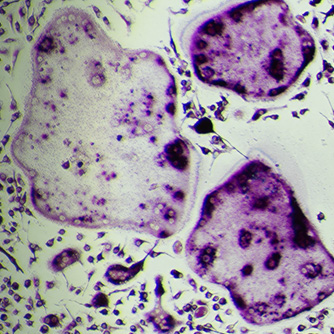Among the functions of the multifunctional milk-derived protein lactoferrin we have concentrated on and conducted research on its ability to improve lipid metabolism. Previous studies*1 have demonstrated that the orally administered enteric-coated lactoferrin tablets, which are processed to ensure that they do not degrade in the stomach but are absorbed in the intestine, reduces visceral fat and BMI*2 (Figure 1).*3 It is generally known that the amount of visceral fat present in a body is determined by the balance of fat synthesis and decomposition, and that visceral fat reduction occurs when fat decomposition exceeds synthesis. Our analysis has also shown that through absorption in the small intestine, orally administrated enteric-coated lactoferrin contributes to the reduction of visceral fat by functioning to both inhibit fat synthesis and promote fat breakdown.*4-6
*1: Healthy Japanese men and women (n=107) took enteric-coated tablets containing 250 mg of lactoferrin or placebo daily for 12 weeks.
*2: BMI (Body Mass Index) =An index used as an indicator of obesity calculated by dividing body weight (kg) by the square of height (m).
*3: S Sato et al.: Enteric-coated lactoferrin decreases abdominal visceral fat in humans -A randomized, double-blind, placebo-controlled, parallel-group study-, Jpn Pharmacol Ther, 48:1179-1185, 2020.
*4: Ono T et al.: Effects of pepsin and trypsin on the anti-adipogenic action of lactoferrin against pre-adipocytes derived from rat mesenteric fat, Br J Nutr. 105(2):200–211, 2011.
*5: T Ono et al.: Potent lipolytic activity of lactoferrin in mature adipocytes, Biosci Biotechnol Biochem, 77(3):566–571, 2013.
*6: K Ikoma-Seki et al.: Role of LRP1 and ERK and cAMP Signaling Pathways in Lactoferrin-Induced Lipolysis in Mature Rat Adipocytes, PLoS One, 10(10):e0141378, 2015.

The effectiveness of the visceral fat and BMI reduction function of enteric-coated lactoferrin, shown in Figure 1, was analyzed again for each subject. These results indicated that some subjects experienced visceral fat and BMI reduction (Figure 1, red-circled area) while others did not (Figure 1, blue-circled area), suggesting that there may be individual differences in the function of enteric-coated lactoferrin. Based on this, we hypothesized that individual variations in enteric-coated lactoferrin function are influenced by single nucleotide polymorphisms (SNPs) and employed genome-wide association studies (GWAS) to identify novel SNPs linked to enteric-coated lactoferrin’s ability to reduce BMI and visceral fat.*7 We discovered multiple SNPs that appear to support this relationship (Figure 2).
*7: Saliva samples were collected from consenting participants from the previous study.*3 GWAS analysis was conducted utilizing visceral fat and BMI data from the previous study.*3

Next, we conducted a thorough analysis of SNPs on genes associated with the visceral fat reduction function of enteric-coated lactoferrin. Specifically, based on the findings of the GWAS analysis, we reassessed the number of SNPs on genes related to enteric-coated lactoferrin’s function, focusing on those demonstrating statistical significance. Based on this, we were able to confirm the presence of SNPs involved in the reduction of visceral fat and BMI on genes that are linked to the action of enteric-coated lactoferrin and have pro-fat degradation or fat synthesis inhibitory effects (Table 1). This indicates that SNPs may affect individual variations in the expression of enteric-coated lactoferrin function.
Table 1. Aggregation of SNPs present on genes associated with the visceral fat reduction function of lactoferrin

The findings of this study suggest that genetic polymorphisms may impact individual variations in enteric-coated lactoferrin function. Going forward, we think that discovering those genetic polymorphisms that impact individual variations in health risks and responsiveness to product functions may facilitate the creation of goods and services that are customized to individual physiologies. We will keep pursuing research aimed at suggesting new habits and products customized to individual consumer needs to support the realization of healthy lifestyles.

Developing Pre-Caries Detection Technologies

Gum Disease Prevention Technology Development Focused on the Periodontal Tissue

Skin Research that Draws Out Skin’s Natural Strength

Study of a Specific Example of Genetic Polymorphism—The Relationship between the Function of Enteric-coated Lactoferrin and Single Nucleotide Polymorphisms (SNPs)

Genetic polymorphisms research to provide individualized healthcare based on each person's constitution
Related Information